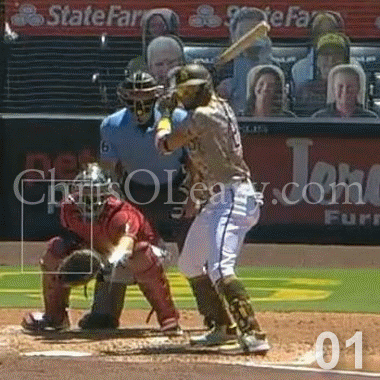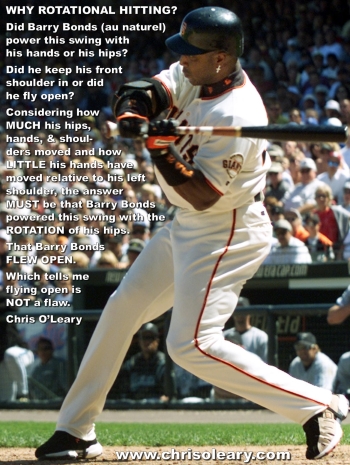| ChrisOLeary.com | ||||||||||||||||||||||||||||||||||||||||||||||||||||||||
| ChrisOLeary.com > BUY > Hitting > Rotational Hitting | ||||||||||||||||||||||||||||||||||||||||||||||||||||||||
|
In sum, rather than moving linearly — taking a big stride to generate a big weight shift and leading with the hands — Williams employed a minimal stride and weight shift and rotated into the pitch, with his hips leading his hands. 
Ted WilliamsWilliams' intuitive insight was to power his swing with the large, powerful muscles that attached to his hips — the muscles of the Core — rather than the small, relatively weaker muscles of the arms, hands, and forearms. 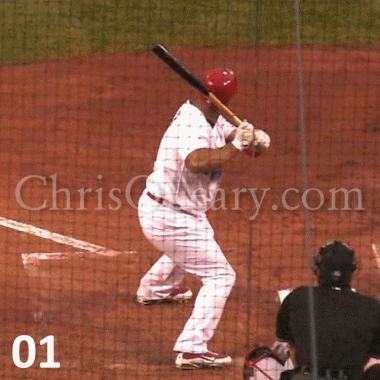
Albert PujolsI came to understand Rotational Hitting by studying how Albert Pujols employed the same basic ideas — with a few, subtle tweaks, needed to address the modern game — with the Cardinals. I then taught those principles to Andres Torres, as he confirmed in an interview with Andres Torres in NJ.com... I know about training, but hitting was difficult. And then in ’08... There’s a guy named Chris O’Leary (a St. Louis fan who kept online flipbooks breaking down Pujols’ swing). He’s online. He talks about Rotation. He's got video examples of Pujols and I watched those. Most recently, I worked with the hitters at Harris-Stowe State University in St. Louis during the 2016 and 2017 seasons.
Some related topics include... Rotational HittingThis piece is an overview of my thoughts about and experience with Rotational Hitting. Why Rotation?Why do I talk about Rotational Hitting — and Rotation, period — when so much of the baseball establishment is reluctant to? Or even hostile to the concept? Andres TorresI talk about Rotation because Andres Torres — my first client to be successful in MLB and first client, period — talked about it. As he did in this interview with NJ.com... I know about training, but hitting was difficult. And then in ’08... There’s a guy named Chris O’Leary (a St. Louis fan who kept online flipbooks breaking down Pujols’ swing). He’s online. He talks about Rotation. He's got video examples of Pujols and I watched those. Andres had been taught to stay closed and throw his hands at the ball. He thought Rotation was the key to his transformation and success as a hitter. And who am I to argue? In his book A Band of Misfits, Andrew Baggerly tells a similar story. But after the 2007 season, Torres remained stuck in Triple A, and he knew something had to change. With the help of Chris O'Leary, a private hitting coach, he began looking at all the video he could find on hitters he admired, starting with Albert Pujols. He saw the way they generated power by rotating through the pitch. I gave him permission to power his swing with Rotation — while staying Connected — as was discussed in this Sports Illustrated article about Andres Torres from 2010 and the middle of the Giants pennant and, ultimately, World Series winning run. Torres' favorite is Pujols. He is in such awe of Pujols' swing that he'll not only watch his at-bats but go online and use Google to find out more. In early 2008 he found some flipbooks breaking down the Cardinals first baseman's swing frame by frame and out of the blue called the website's creator, a St. Louis area suburban dad named Chris O'Leary who has read voraciously about hitting but has no professional background, and said, "Hey, I read your stuff. It really made a lot of sense. Tell me more about Connection." If Andre Torres thinks Rotation is important, then who am I to disagree with him? Albert PujolsI talk about Rotation because it is what the best hitters — of the present and the past — did and do. 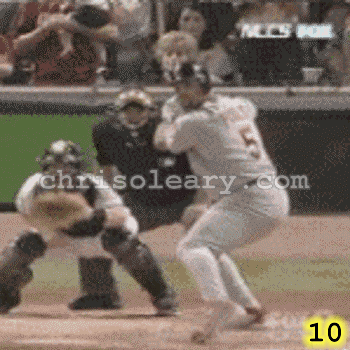
Albert PujolsI had no problem calling what I saw in the clip above Rotation. What word would you use? Other than Rotation? Roberto ClementeI talk about Rotation because it's what I see in this clip of Roberto Clemente. 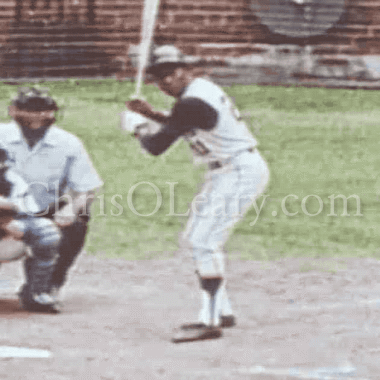
Roberto Clemente Home Run SwingWhat word would you use to describe what Clemente does to get to Contact? Other than Rotation? Aaron JudgeI talk about Rotation because of what I see in this clip of Aaron Judge. 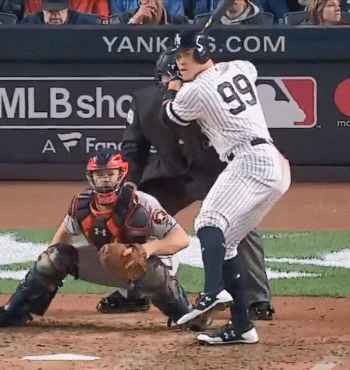
Aaron Judge Home Run 2017.10.16What word would you use to describe what Aaron Judge does to get to contact? Other than Rotation? Juan SotoJuan Soto is one of the hottest young hitters. 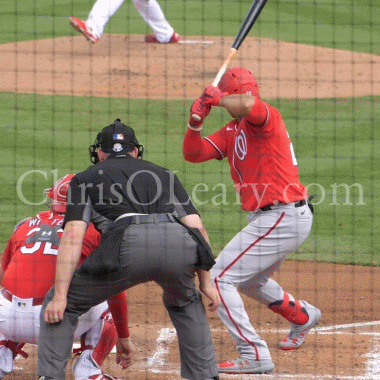
Juan Soto
|
|
YEAR |
AVG |
SLG |
OBP |
|
2014 |
.298 |
.412 |
.369 |
|
2015 |
.263 |
.357 |
.350 |
|
2016 |
.311 |
.449 |
.400 |
|
2017 |
.334 |
.472 |
.420 |
|
2018 |
.286 |
.424 |
.387 |
|
2019 |
.276 |
.434 |
.354 |
HSSU achieved a dramatic improvement in its offensive performance in a short period of time during the 2016 season and sustained — and improved on — that success during the 2017 season.
What's more, HSSU then regressed when I left and traditionalist, Linear Hitting guys took over.
In sum, I have found that Rotational Hitting can work at the college, minor, and major league levels of baseball and fast pitch softball if you know what needs to be added to make it work.
Rotation vs. Spinning
The resistance to Rotational Hitting is due, in part, to a generally poor understanding of the concept of Adjustability, which helps to make Rotation and Rotational Hitting different — and more than — than just Spinning.
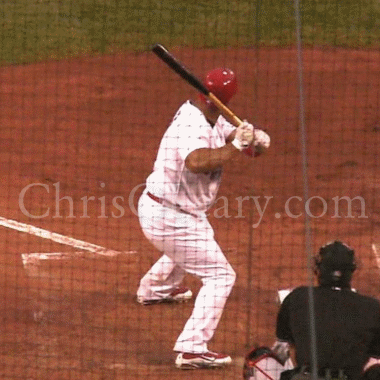
Albert Pujols Demonstrating Rotation
That's a distinction Francisco Lindor, who is one of the best current hitters and believes Rotation is a key to the High Level Swing Pattern, recently made to Alex Bregman.
Francisco Lindor July 15, 2020
The strength for me -- and, I believe, for most hitters, unless you are really strong in your upper body -- comes from your hips and your legs.
The faster you can move your hips — you can Rotate — the faster your hands are going to get to the ball.
Your barrel will get to the ball.
And if you're in your legs — on your legs — you will be able to Rotate.
Not Spin.
Rotate.
I want to Rotate.
And that allows my to put myself into a good hitting position.
Who am I — and who are you — to argue with Francisco Lindor?
Making Rotation Work
I believe the problem people tend to have with Rotational Hitting is that Mike Epstein's approach to teaching Rotational Hitting is a flawed interpretation, and not a strict implementation, of Ted Williams' ideas. What is required to make Rotational Hitting work is go back to the original sources and dig into what Ted Williams wrote and (really) said.
You must also augment Ted Williams' core concept...
- Rotation
...with a number of complementary concepts, including...
- Connection
- Adjustability
- Timing
...that adapt Ted Williams' ideas to the modern game.
And strike zone.
Straw Man
One criticism of my work is that all I teach is Rotation, and that means that my hitters spin.
I would hope that my discussion of concepts other than Rotation make it clear that that is a Straw Man Argument.
One based on a misrepresentation of what I teach.
Flying Open
But what about flying open?
Aren't I encouraging hitters to fly open by talking about Rotation?
Yes.
But that's not a problem if you take my complete system, and all of the concepts I talk about, into account.
As I found working with the guys at HSSU, where many of the other coaches derided me and my work because of my emphasis on Rotation, most of the problems they attributed to Rotation were actually problems with the Timing of Rotation, not Rotation itself.
That is exactly what Mark Trumbo found when I worked with him in 2014.
Rotational Hitting 101
As I live in St. Louis, I came to understand Rotational Hitting, and the concepts that adapt it to the modern game, by studying the swing of Albert Pujols and putting together my flipbook swing analyses.
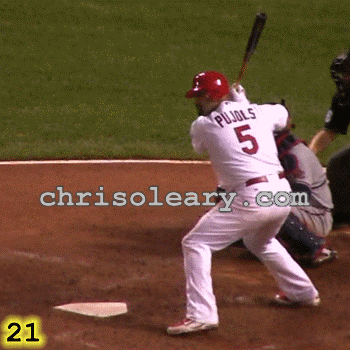
Albert Pujols
Since 2005, I've devoted myself to studying the swings of other great hitters, including Mickey Mantle and Miguel Cabrera. In 2008, my writings about Albert Pujols' swing attracted the attention of a career minor leaguer named Andres Torres...
I know about training, but hitting was difficult. And then in ’08, I was working with a lot of guys. There’s a guy named Chris O’Leary (a St. Louis fan who kept online flipbooks breaking down Pujols’ swing). He’s online. He talks about Rotation. He's got video examples of Pujols and I watched that.
If Andres thought Rotation was the key to his turn-around, who am I to argue with him?
Andres Torres went on to help the San Francisco Giants win the 2010 World Series.
Why Rotation?
Why do I talk about Rotation, given the baggage associated with the term Rotational Hitting?
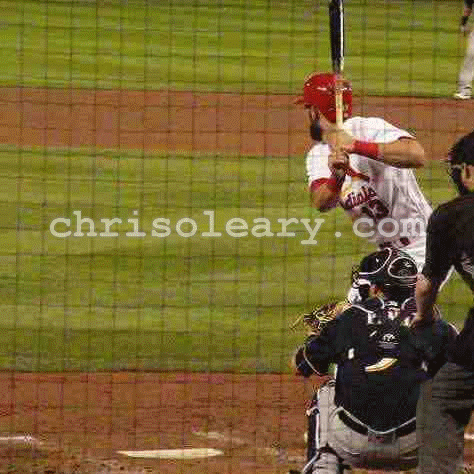
Matt Carpenter Rotating Into Contact
Believe me, if I could think of a better word to use to describe what Matt Carpenter is doing in the clips above and below, I would.
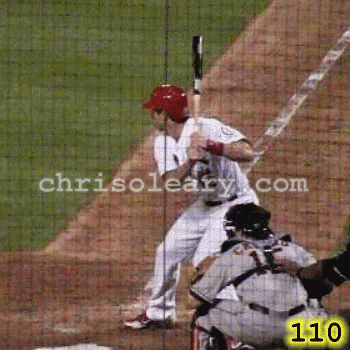
Matt Carpenter Rotating Into Contact
However, I can't think of a better term to characterize Matt Carpenter's swing than "Rotational." As a result, I've decided to just live with the term and suggest you do the same.
Ted Williams' Concern
Ted Williams' focus on the Rotation of the hips stood in sharp contrast to what he felt was the (over) emphasis on...
- Weight Shift
- Extension (at Contact)
- Swinging Down for Backspin
...that were the focus of Charley Lau and disciples like Walt Hriniak.
Ted Williams knew the high-level swing combines Linear and Rotational elements.
The clip below shows Ted Williams employed a stride.
A Linear movement into Rotation.
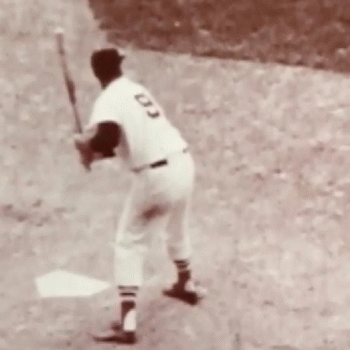
Ted Williams
A balance of Linear and Rotational movements.
What Ted Williams was aware of, and was concerned about, were the limitations of the overly or solely Linear swings that were being taught in the 70s and 80s. He knew they were working only due to the nature of the ballparks of the era; gigantic fields where a thin layer of Astroturf covered a hard layer of concrete.
The Problem
The problem is that overly Linear thinking remains a problem.
That is why I lead with the concept of Rotation, even though the high-level swing is both Linear and Rotational.
I'm just trying to get hitters back to the balance of Linear and Rotational elements that Ted Williams employed.
However, if you listen to MLB coaches and analysts, many seem to be fixated on trying to coach Rotation completely OUT of players' swings, likely because that is what they were taught and it is what worked in their era. However, while limiting Rotation can work as a cue for some hitters, it doesn't reflect reality; it's not what great hitters like Ted Williams or Mickey Mantle actually did.
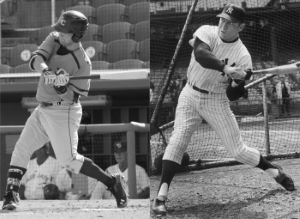
MiLBer and Mickey Mantle
Unfortunately, players like the one above are being coached OUT of Rotation and Mickey Mantle's swing — by a now-MLB hitting coach — and are being coached out of baseball.
Which is tragic.
Not to mention a waste of talent.
Balance in all Things
A purely Rotational swing would be just as flawed as a purely Linear swing.
I learned that lesson the hard way when trying to use Mike Epstein's, Jack Mankin's, and Paul Nyman's ideas when working with my older son.
I found the high-level swing must combine Linear and Rotational elements.
But in balance.
In the end, I found I needed to develop my own, more comprehensive approach to teaching hitting. I have since used and refined my approach with a number of now major league hitters.
Rotation is only one of a number of concepts I discuss.
In fact, Mark Trumbo has credited much of his recent success to my helping him understand the concept of Timing.
Why Rotation & Rotational Hitting?
As I discuss at length in my Rotational Hitting FAQ, I was attracted to the concept of Rotational Hitting because I thought Rotation was a good way of describing what I was seeing in the swing of Albert Pujols in his prime.

Albert Pujols
In the clip above, which shows Albert Pujols hitting THAT home run off of Brad Lidge, does he stay closed? Does he keep his front shoulder in?
Maybe early on in his stride and swing, but certainly not into contact.
The self-evident truth of Rotation led me to study both Ted Williams' ideas and Mike Epstein's approach to teaching them. However, as I discuss at greater length in my Mike Epstein guru guide, I came to understand that Mike Epstein at best ignored what Ted Williams emphasized in The Science of Hitting.
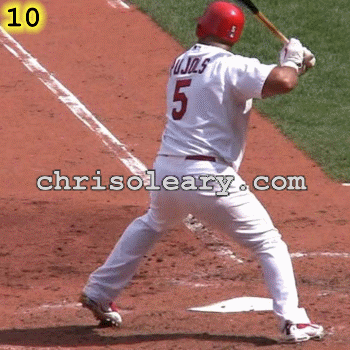
Albert Pujols
What Mike Epstein taught was subtlely, but as I was to learn, significantly different than what Albert Pujols did.
I then began an intense, in-depth analysis of Albert Pujols' swing, including putting together a number of now-famous flipbook swing analyses.
As I discuss in my experience with Andres Torres, my analyses of Albert Pujols' swing were discovered by Andres Torres in 2008. He contacted me and I helped him rebuild his swing and approach and he helped the Giants win a world championship in 2010.
I continue to think and talk about Rotation, and use the term Rotational Hitting, because I think it remains an important and useful concept, especially given the proliferation of cues like...
- Keep your front shoulder closed.
- Don't fly open.
- Don't pull off the ball.
- Don't spin off the ball.
If you don't understand how a hitter can Rotate while not pulling/spinning off the ball, then I'd suggest you don't understand Timing and Adjustability, two concepts that were key to Mark Trumbo's resurgence.
My Story
As a kid, I loved the game of baseball. However, I was never a great hitter. While some of my problems were admittedly due to my not wanting to wear my glasses, most of my problems were due to poor hitting instruction.
I wasn't taught to do what great hitters (actually) do.
I was taught to transfer my weight from back to front, to keep my hips closed into contact, and to hit the ball at full extension and make the Power V at the point of contact.
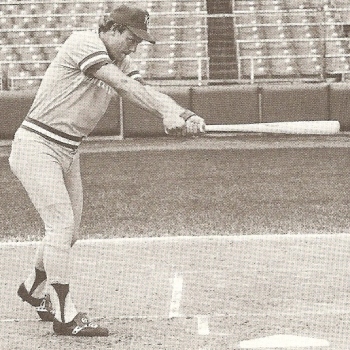
George Brett
Just like George Brett did.
Or so I thought.
As I had kids of my own and coached them and their friends, I resolved to teach them better than I was taught. In my case, I started with Jack Mankin and then, following the lead of everyone I knew, moved on to Mike Epstein.
However, and following some very good advice, I eventually realized I needed to drill down to and read Ted Williams' own words and ideas, not Mike Epstein (and Steve Ferroli's) interpretations of them.
All the while, I was independently studying what the best baseball players (actually) do, starting with my flipbook analysis of Albert Pujols swing.
Mike Epstein Vs. Charley Lau
To understand why the term Rotational Hitting made — and still makes — sense, you have to understand what Charley Lau and his disciples like Walt Hriniak were teaching during Mike Epstein's day and, in many cases, still teach.
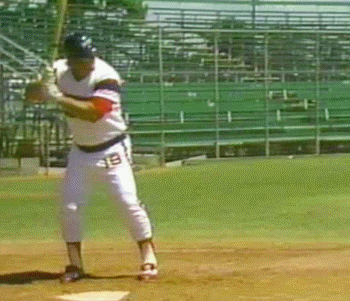
Greg Luzinski
In sum, the Lau approach, at least when it comes to the lower body, is that all the power comes from the...
- Stride
- Weight Shift
As you can see in the clip above of Greg Luzinski, which was taken from Charley Lau's DVD, the hips stay closed into the Point Of Contact. There is no separation or torque. The hips, shoulders, and hands move together because it is believed that any rotation of the hips will cause the front shoulder to fly open.
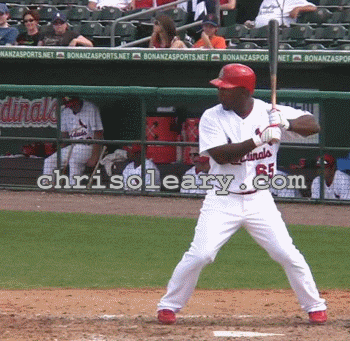
Joe Thurston
Joe Thurston's swing was the closest I've ever seen to a textbook Lau swing in a (more) recent player, and he barely made it work in the major leagues.
Why Rotation?
Given that the high-level swing combines both linear and rotational components, and the term Rotational Hitting carries with it significant baggage due to Mike Epstein, why would anyone still focus on Rotation and not something else?
While I use the term the high-level swing to characterize what I teach, I continue to talk about the importance of Rotation, and use the term Rotational Hitting, because it...
- Encapsulates the thing that Ted Williams emphasized; the rotation of the hips ahead of the hands.
- Contrasts with the conventional wisdom that too often — and, in my experience, increasingly — views rotation, and being rotational, as a bad thing.
I was reminded of the value of the concept of Rotation during the fall practices of the college baseball team I work with.
The problem was, when looking at video of their swings, too many of our hitters were using terms like "Flying open" to criticize what were, in truth, good swings. Then, in an attempt to fix something that wasn't broken, they developed an actual problem with covering the entire plate with power, I believe in part due to their efforts to not fly open.
Don't get me wrong.
Cues like "Stay closed" and "Keep your front shoulder in" can and do help some hitters. When they are interpreted advantageously.
However, those cues are just that.
Cues.
Not reality.
In truth, when it makes things better and not worse, telling a hitter "Don't fly open" works by DELAYING the start of rotation, not by PREVENTING rotation.
As our head coach so effectively summed up to one of our hitters, trying to not fly open works by altering the TIMING of Rotation.
Not by eliminating Rotation.
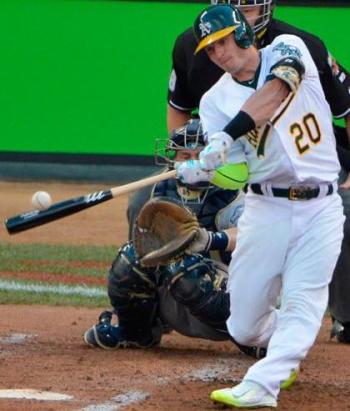
Josh Donaldson Rotating
I simply don't know how else to describe what Josh Donaldson is doing in the picture above other than to say that he's rotating his hips, hands, and shoulders.
A lot.
The reality is that the high-level swing is powered primarily by the Rotation of the hips. The hips then pull the shoulders and the hands around, allowing the hands to focus on adjusting to the location of the pitch.
The problem is that it's easy to find people who at best talk down rotation and, in the worst case, try to eliminate it from their hitters' swings.
Mike Epstein & Rotational Hitting
Rotational Hitting is often associated with Mike Epstein, who was influenced by Ted Williams.
In my (direct) experience, Mike Epstein's ideas and approach were a significant advance over the approach of Charley Lau, Walt Hriniak, Don Mattingly and others that I was taught. However, and also in my experience, Mike Epstein's approach to teaching Rotational Hitting was far from perfect.
The problem is that Mike Epstein's approach to teaching Rotational Hitting is incomplete.
It's an interpretation, not an implementation, of Ted Williams' ideas.
As I found when using Mike Epstein's ideas with my older son and his friends, important parts of Ted Williams' thoughts and swing — in truth, the core of Ted Williams' approach to generating power — aren't discussed by Mike Epstein.
What's worse and as I touch on in my piece analyzing Dave Hudgens' views on hitting, in some cases what Mike Epstein teaches runs counter to, or worse inhibits, what Ted Williams did.
Beyond Mike Epstein
As I explain in greater detail in my discussion of the strengths and weaknesses of Mike Epstein's system, when my older son started to struggle with his hitting, everyone I knew told me to get Mike Epstein's books, CDs, and DVDs. I did, and found them to be a significant advance over the nonsense I had been taught about hitting.
However, while my older son's swing improved significantly, he continued to struggle with fundamental problems like Bat Drag, which Mike Epstein's materials didn't alert me to or help me with.
As a result, I decided that I had to go beyond Mike Epstein's materials. That meant doing two things...
- Buying a high-speed camera, attending 50 to 75 major league games per year, and studying what the best hitters actually do.
- Reading, re-reading, and re-re-reading Ted Williams' The Science of Hitting and literally everything he wrote and said about hitting.
Rotational Hitting 2.0
Since 2008, first with my Rotational Hitting 101 DVD and today with my client site and supplementary webbooks, eBooks, and flipbooks, I have been working to bring Rotational Hitting closer to what Ted Williams laid out in The Science of Hitting.
Andres Torres, shown below hitting a home run during the 2010 World Series, was my first client.
Andres Torres used my DVD to help turn around his career and help the San Francisco Giants win a world championship in 2010.
Since then, I have helped a number of major league baseball players either get to the major leagues or improve their performance. That includes...
The High-Level Swing
Since 2006, I have been studying the swings of the best baseball and fast-pitch softball players and working to understand the high-level swing. As part of that process, I have collected large amounts of high-quality, HD and slow motion video of the best baseball and fast pitch softball players.
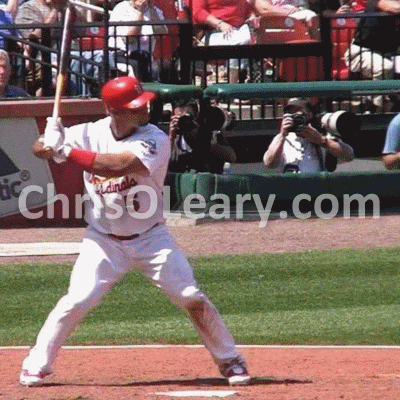
Albert Pujols
The goal is to bring Rotational Hitting instruction closer to its roots; to what Ted Williams talked about in The Science of Hitting and, more importantly, to how great hitters actually swing the bat.
Rotational Hitting 101 DVD
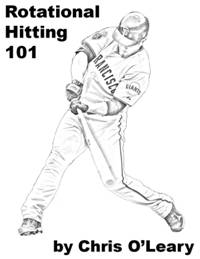 In
2008, I took much of the information that had been blogging about,
organized it, added to it, and put together
Rotational Hitting 101 and
my
client site. They reflect the lessons that have been learned
about the high-level swing over the past ten years. They build on
the strengths, but also address what in my experience are the
weaknesses, of Mike Epstein's approach to teaching hitting.
In
2008, I took much of the information that had been blogging about,
organized it, added to it, and put together
Rotational Hitting 101 and
my
client site. They reflect the lessons that have been learned
about the high-level swing over the past ten years. They build on
the strengths, but also address what in my experience are the
weaknesses, of Mike Epstein's approach to teaching hitting.
Since I first published Rotational Hitting 101, I have shipped more than 2,000 copies of my DVD to people all over the world including Andres Torres, my first professional client.
Andres used the information on my DVD, and in particular my information on Connection, to rebuild his swing and his entire approach to hitting. The result was a swing that helped the San Francisco Giants win the 2010 World Series.
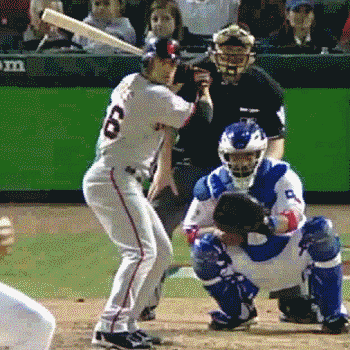
Andres Torres
Home Run to Right Field
2010 World Series
Major League Experience
Andres Torres isn't the only major league baseball player I have worked with.
At last count, I have three other clients in the major leagues, two clients at AAA, one client at AA, and two clients playing for independent minor league teams and trying to get back on the road to the major leagues. I have also worked with a number of D-1 college baseball and fast pitch softball players.
I don't give out the names of these players because I don't want to get them in trouble with their coaches. While they, and I, believe in what I teach, most of the time it contradicts what their coaches are saying, so they have to keep it to themselves and we have to work on the down low. If you are a minor leaguer and are looking for help, e-mail me and we can talk about how you can get access to my client-only web site.

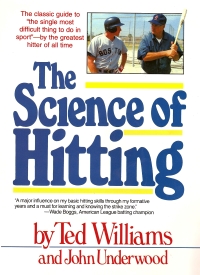 Rotational
Hitting is the term that is used to describe Ted Williams' thoughts
about hitting as laid out in his seminal work, The Science of Hitting.
Rotational
Hitting is the term that is used to describe Ted Williams' thoughts
about hitting as laid out in his seminal work, The Science of Hitting.